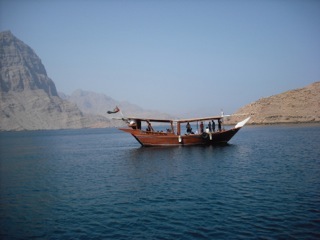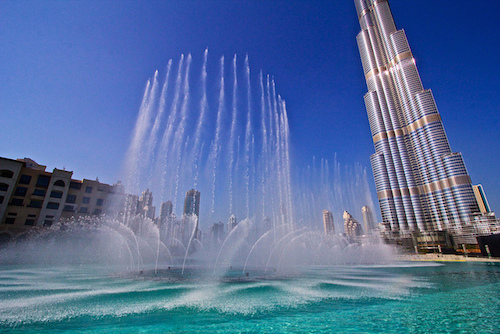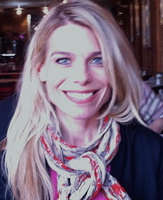“You just have to see this city to believe it,” I found myself emailing friends and family back home in the U.S. several summers ago.
The sense of a place striving was thick.
But it was more than a striving. The reality of the psyche of Dubai was as real as the cranes saluting the skyline, resulting in skyscrapers and deluxe shopping malls springing up as quickly as sandstorms.
When you move to Dubai in summer, you frankly deserve the punishing desert heat. I knew this and more or less acclimated.
The weeks passed and while enjoying the view from our balcony late one night, my husband and I commented that it felt cooler.
“It’s actually bearable!” we gushed.
We relished like old-timers who had adjusted and could spot a 1 degree change of temperature. Inspired, we sought to verify our educated guess, and yes, it was cooler: 110 degrees.
Using their fresh understanding of metaphors, our school-age children suggested,
“Dubai is a microwave.”
Actually, the microwave was tolerable when we followed the masses and common sense, taking in many adventures in the numerous and amply cooled shopping malls, one in particular so cooled as to house Ski Dubai, an indoor downhill skiing center.
What couldn’t Dubai do? I wondered.
Perhaps that was naiveté speaking. What I do know is that I was beginning to see what affluence and ambition could do for a city. (I wasn’t yet aware of its shortcomings.)
A few weeks into our time in Dubai, I re-invented the “I-Spy” game with our children in an effort to fully appreciate the desert sky and drive home the relationship between clouds and rain. But “I Spy a Cloud!” was a flop in August and our umbrellas stayed in the closet, utterly useless.
The few clouds we did spot during our three-month stay in Dubai appeared lonely and gaunt.
Increasingly, I was haunted by the similarity of those few clouds with a section of Dubai’s population whose voice is unheard in the glossy travel advertisements.
But, water was everywhere.
Indeed, the creative displays of water ubiquitously peppered around Dubai were breathtaking. As plentiful indoors as outdoors, the presence of water served as a foil against the parched earth. Soothing statuesque fountains, rushing waterfalls and winding waterways were artistically impressive and gorgeously constructed.

The scope of each project reflected an unrestrained budget, both in construction costs as well as future maintenance requirements. Water’s premier place of importance in the landscape design around the Burj Khalifa, the world’s tallest structure, seemed to invite comparisons to an exuberant, animated prop.
My initial impressions were positive. The mere sight and sound of rushing water was therapeutic, a step toward easing my prevailing sense of thirst I felt from the first moments of landing on desert soil, a first-timer to the Middle East.
Walking off the airplane, into the vast confusion of the airport masses where we were easily the minority and hearing the first of many hundreds of forceful calls to prayer over a loudspeaker, I became aware of my excessive thirst and thought I’d hit the first drinking fountain as we threaded our way toward customs.
There were none to be found.
Life unwrapped itself and I observed that like other countries I had visited, public drinking fountains were simply not the norm. The drinking fountain was an American expectation I’d unconsciously carried with me. Along with differing cultural practices, there was, too, the global rise of bottled water that to some degree made the drinking fountain a supplanted (if not outdated) consideration.
But unlike other countries I’d visited, Dubai’s temperatures can reach 119 degrees.
Unlike other countries, there is the ever-presence of sand, underscoring a lack of moisture and a fierce feeling of thirst.
Unlike other countries, Dubai’s mantra of excessiveness proves the existence of deep pockets. Not only did drinking fountains seem entirely possible, they made sense.
Was Dubai building with people or image in mind?
The city’s official tourist booklet we received upon our arrival deemed tap water “safe” for consumption but that, “it doesn’t taste particularly pleasant” and bottled water was recommended.
Coming from Washington, D.C. where spin and messaging is an art form, this seemed odd bidding from a wealthy nation marked by refined and discriminating tastes.
We were assured that the water was potable and safe, and simultaneously encouraged not to drink it.
For reasons beyond taste, our seasoned expat friends didn’t even consider drinking the tap water. Neither did we.
Dubai’s conventional wisdom grew increasingly apparent the longer I lived there. Attention was given to building a desert metropolis out of the sand to be enjoyed by the privileged, overpowering any thought of what was necessary for the laboring class.
Dubai seemed to be bypassing the immensely challenging and expensive priority of procuring delicious drinking water to be enjoyed freely by all.
Perhaps Dubai would have a wildly different public image if it were based on what gurgled out of the tap. My eyes were starting to open to the injustices, yes, gurgling below the arresting beauty of the city.
Don’t swallow the water when you’re brushing your teeth, I’d instruct our kids. They were terrified they’d catch some strange disease and were exceedingly careful.
Yet, it was impossible to ignore the water’s saltiness even with such brief contact. It reminded me of my childhood. My mother insisted on the home-remedy of gargling salt water to combat sore throats or cold sores. And we would never have dreamed of swallowing that salt-infused concoction.
A basic fundamental was missing, while glitz and glam were not.
As I came to admire up-close the unequaled ambition and wealth wrapped up in building the 2717-foot Burj Khalifa and the ground-breaking Palm Jumeira with The Atlantis serving as its exotic terminating vista, the thought persisted: certainly Dubai could afford to splurge on the humble drinking fountain producing cool, fresh water. This would amount to an unmatched public good that promotes life at its most basic level.
After all, one can’t drink grandeur.
That was it, I thought: this place was serving as an effective instructor. After all, it’s human nature to allow opulence to obscure the rotting underbelly of complex social problems. Thankfully, I wasn’t spared this revelation—about Dubai—and about myself.
The beautifully furnished condominium temporarily provided for us by my husband’s firm was in an elegant building of such living quarters, designed to attract and please expatriates who had come to Dubai on their own terms.
It was from the warm interaction with the staff, mostly hailing from Southeast Asia, that I was vaguely made aware of such a place as labor camps. In Dubai where luxury was commonplace, I struggled to comprehend that these genuine, hard-working people went home each day to labor camps.
In my mind, it was a paradox of mammoth proportion. It seemed utterly incompatible with the Dubai I had stepped into and would leave in a few months.
Each afternoon, the kids and I would lounge around the gorgeously appointed condominium pool in an attempt to engage the outdoors in spite of the sweltering temperatures. I would grab some shade and work by the pool while the kids would thrash around for hours in the warmish water.
In Washington, D.C.’s muggy summer, I had insisted on engaging the outdoors in spite of the heat. With the crippling high temperatures, Dubai’s summer was far more difficult, even with a pool at our disposal.
From the Philippines, a clean-cut young man in crisp pants and a neatly pressed button-down shirt would daily service the pool area, tirelessly providing fresh towels, opening umbrellas for the clientele and cheerfully handing out cold water bottles.
Kenneth increasingly extended himself to the kids the longer we lived there, going out of his way to make their pool time happier by fetching inflatable rafts from a storage closet. Ever a presence, Kenneth would circle among the guests with a basket of chilled water bottles and as often as we liked, we were able to ask him for more.
The heat was so oppressive that the pool couldn’t be enjoyed without staying hydrated and nothing brought relief like those cold water bottles.
But I never saw Kenneth drinking one. Did he have to watch us enjoying all that bottled water day after day without the same satisfaction waiting for him at least when he got off the clock?
While there are surely many outstanding needs felt by this hard-working community, who would argue that healthy drinking water isn’t fundamental?
If Dubai could commit to making the enormous investment in rethinking its water standards, the action would bring the city some great international publicity.
Human rights groups would praise their efforts for the city’s low-income community. Environmental groups would applaud the campaign as a direct attempt to curb the consumption of water from plastic bottles. It would deepen trust from foreign governments and investors.
After all, if not driven by altruistic motives, why not then shamelessly go for some great publicity?
I now viewed the water gushing and splashing rhythmically out of ornate fountains around the city as ironic. More than that, it produced a pulsating sense of injustice. The perfectionism of Dubai’s water landscape architecture—no matter how eye-catching—could not make up for what came out of the tap.
For all of Dubai’s riches, drinking water is simply hard to come by in the desert. This desertscape was opening my eyes like never before to the value of water. When something is lacking, the power of desire for it is exponentially increased. Especially here, water was precious in ways money couldn’t explain.
It’s life itself.
The paradox was hard to miss in this city of seven star hotel opulence. For some, luxury was a night in Burj Al Arab’s penthouse suite. Twenty-three thousand dollars for one night anyone? Luxury was even present in Dubai’s law enforcement, which patrolled the city in Lamborghini Aventadors.
For others, healthy drinking water was an unaffordable luxury. Dubai had opened my eyes to shocking beauty and shocking ugliness.
“Where are all the people?” came the innocent reaction to our family beach photo from a sister in Oregon where summers don’t ever warm ocean waters.
She saw the gorgeous blue-green, the white sand and bright cloudless sky over the Arabian Gulf, as the Persian Gulf is tenaciously referred to here. She saw our smiling faces popping out of the water undisturbed by other bathers and queried the obvious—where’s the crowd?
Why were we out there in the water alone?
Well honestly, sis, we’re the crazy ones, I had to confess. Swimming pools were rational because water temperatures could be cooled, but ocean-water during the height of summer? Plainly, irrational.
We went with rational except for the couple of times we fit the part of crazy tourists, took our sorry bodies to the beach and suffered the extreme heat of the extremely salty water.
Simply put, there are reasons the Arabian Gulf is not ideal for swimmers despite its amazing beauty and even less ideal as a source for drinking water.
In a quest for potable water, the many nations lining the shores of the gulf over time have left brine behind from the desalination process. Move west past Abu Dhabi, the capitol of The United Arab Emirates and you’ll arrive in Qatar. Then Bahrain. Then Kuwait. Iraq. Iran.
This practice has contributed to the vicious cycle of the gulf growing saltier and more difficult to convert into drinking water. The occasional sewage spill and random refuse left in the wake of oil tankers and other boats that ply the gulf waters has further polluted the water.
Adding exponentially to the problem, the gulf’s circulation is naturally challenging. The gulf is constrained by the hairpin turn we call the Strait of Hormuz, bottling up the ever-increasingly troubled body of water.
I was able to stare into the face of the Strait of Hormuz during the one time we left the kingdom. Following the shoreline out of the United Arab Emirates to its tiniest tip of Musandam, Oman, we checked into our hotel outside of Khasab. Our expat friends had suggested Muscat, but for those who are perpetually thirsty and craving water, a long drive through the desert in the extreme heat sounded like Hades itself.
Instead, we chose the windy forsaken road along the remote coastline to Musandam, Oman. It followed the script I found myself in, a script acknowledging both the human need and desire for water. Entering Musandam, the ominous rocky landscape out of the car window on our right was answered by the glistening reassuring water on our left.
Puffed up with vanity, the gleaming water was a nod to water’s placebo effect. The water was also a palpable testimony to man’s dependence on it. Throughout human history, water has emerged as a laughing strongman with his plot-manipulating moves, delivering blessing or curse, nourishment or impoverishment.
Too much or too little—and we fragile humans are in trouble.

Looking out of our hotel, I warily spotted Iran in the distance and noticed the cigarette boats skimming the water, making runs across the strait from Iran to the mainland (with who knew what).
Gazing at this narrow passageway that connects the Arabian Gulf to the Arabian Sea was a tutorial on just how hemmed in Dubai and other gulf populations were. They comprised a gated community standing with backs to the desert and hopeful faces to the glorious but infected water of the gulf.
One lone concerned—and thirsty—American mom aside, how was Dubai to solve the long-term problem of providing safe and delicious water for its swelling population?
The obstacles were different, but Rome found a way and still today, cool drinking water comes bubbling, splashing onto the squares around the city.
Perhaps this ready availability of fresh drinking water for all socio-economic groups is what sets the foundation for true opportunity and human flourishing. In Dubai, good drinking water was synonymous with purchased bottled water, which signaled privilege.
For Kenneth, healthy, fresh drinking water was a missing fundamental. The cool bottled water Kenneth served the elite international society around the pool didn’t placate his own desire for the same.
From what I observed, hope is a rational disposition. It’s not a matter of if, but when, because doing what can’t be done seems to energize Dubai.
Specializing in the impossible, Dubai has emerged as the poster-child for nature-defying creations. What is more nature-defying than expanding into the desert on a footprint of 3 billion square-feet to create Dubailand, a city unto itself?
Or, consider the recently completed Cayan Tower. Globally turning architect and engineers’ heads, this 1,000-foot structure spirals 90 degrees. Another example of ambition materializing.
The world has watched public and private investments result in seemingly impossible projects in Dubai. For good reason, the world will continue to watch it because in a very tangible way, time does not stand still in that city.
Something bigger and better is constantly being unveiled. It may be shocking. It could be ridiculous. But it’s overflowing with confidence, motivation and the unerring belief that anything is possible.
But mere confidence in Dubai doesn’t satisfy my thirst and certainly not the thirst of Dubai’s hundreds of thousands of guest workers.
Instead, can anyone point me to the nearest public drinking fountain?
If so, this amounts to sorely needed evidence that the ruling class respects the working class. I’ve grown bold from my peak, albeit brief, of Dubai and I’m wagering that a public drinking fountain has probably just been built and already earned well-deserved international accolades for its beauty and design.
Better yet, the water gurgling out of the fountain is not only healthy, it’s probably so fresh-tasting that bottled water companies are green with envy.
Change is in the air, a sensation that only rain on the face could top. It is, after all, Dubai.
Love elephant and want to go steady?
Sign up for our (curated) daily and weekly newsletters!
Apprentice Editor: Brandie Smith/Editor: Catherine Monkman
Photos: Dan Heap/Flickr Creative Commons, Colin Capelle/Flickr Creative Commons, A {heart}/Flickr Creative Commons, Courtesy of the author.













Read 7 comments and reply